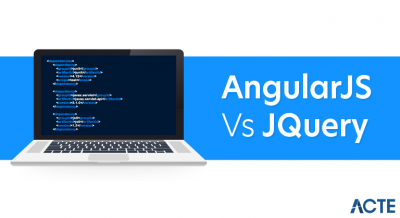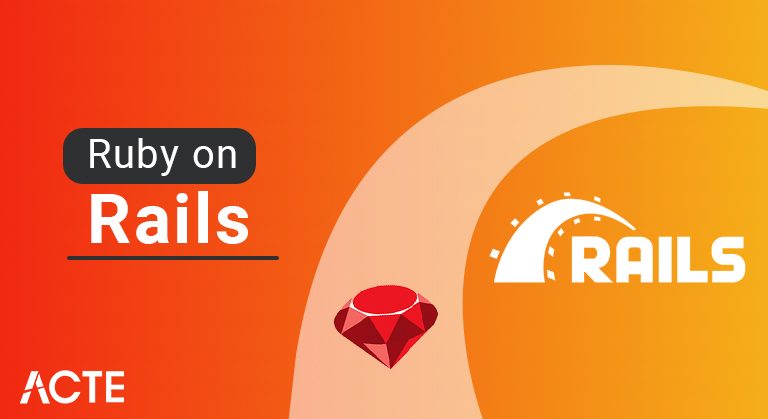
Ruby on Rails is an open-source software used to build web applications. Rails is a framework used to create websites using the general-purpose programming language Ruby. Ruby ranks amongst the top ten programming languages predominantly because of the voguishness of Rails.
- Introduction to Ruby on Rails
- Basics Concepts of Ruby on Rails
- Getting Familiar with Rails
- Market Trends for Learning Ruby on Rails
- Career Prospects for Ruby on Rails
- Get Your Career on Track by Learning Ruby on Rails
- Need For Ruby On Rails Training
- Advantages of Ruby on Rails
- Demand for Ruby on Rails Skills
- Roles & Responsibilities of a Ruby on Rails Professional
- Conclusion
- Ruby on Rails (or simply Rails) is an MVC (Model View Controller) based framework used for web development and app programming on the server-side of applications. In the world of web development, web frameworks are based on a specific programming language. For example, AngularJS is a JavaScript-based web framework. This means that all the libraries contained in AngularJS are written in JavaScript. In the same way, Rails is a framework written in the Ruby language and extends Ruby to solve problems without a programmer having to reinvent anything.
- Ruby on Rails developers love it for its time-saving properties when writing code. The efficiency of Ruby on Rails is due to its ready-made code libraries that contain advanced solutions, saving the time required to perform repetitive tasks such as creating forms, menus and tables.
- In this article, we’ll explore Rails programming and provide you with relevant resources to help you navigate a course toward lucrative career options such as an automation test engineer. Learning Ruby will also prepare you for full-stack development.
Introduction to Ruby on Rails:

Basics Concepts of Ruby on Rails:
Whether you are a seasoned programmer or have never written a single line of code, your decision to learn Ruby will open you up to new career possibilities. Back when Ruby first debuted, it was just one file. Today, however, it has evolved into a vocabulary of words, some of which include:
It is a general term used in various programming languages. It is a version control system that allows you to save versions of code and see which lines are written.
Github / Bitbucket. This is where developers host and store their projects. To understand this better, you can compare it with Dropbox or Gdrive, only with unlimited free space.
RubyGems. It is Ruby’s package manager. RubyGems standardised formats for distribution of Ruby, defines a standard directory format, and allows easy installation of gems.
Gemstone. These are utilities and libraries that make up the code created by a community of programmers.
bundler. It tracks the gems you’ve used on your Ruby project so that whenever a gem is updated, your code doesn’t break, and your projects will keep running.
bundler audit. Built on top of Bundler, it is a gem that is trusted and recommended by experienced programmers like RubyGarage. Bundler Audit searches your gems for security vulnerabilities.
- DRY (Don’t Repeat Yourself), RESTful, Convention on Configuration, CRUD, etc.
- Dry. By employing the DRY principle “each piece of knowledge should have a single, clear, authoritative representation within a system”, developers don’t need to write the same code over and over, and you achieve standardisation.
- Convention over configuration. It is a paradigm towards increasing productivity by following coding conventions and the best way to do things.
- CRUD stands for Create, Read, Update, Delete. It is a function that guides actions on a database.
- REST, short for Representational State Transfer, guides actions performed on URLs.
- Thinkful also has a Ruby on Rails tutorial that covers these and other topics, but one important element they point out is the need to choose a target. They recommend applying your skills to something unique but simple. If you have a small but serious problem that you can solve with your new programming skills, learn Ruby, and apply your skills to solve it. After practising a lot of small goals, you will be able to handle more important projects.
- Note that although a novice can learn Rails and become proficient very quickly, prior knowledge of the Ruby language is an added plus as it will shorten your learning curve. While Ruby will equip you for full-stack development, Ruby Garage also recommends learning CSS, JavaScript, and HTML to better understand the basics of front-end development. While all of this may seem like a lot to learn, it’s a great way to work towards a more attractive pay bracket in Java development, so you’ll never lose out on learning these additional programming languages.
- Note, however, that Ruby is more than enough to help you get started coding, and you can map out all other languages in your career path.
Getting Familiar with Rails:
You can learn Ruby on Rails programming from many reliable sources. For example, Rails Guide has a comprehensive guide that covers the following areas:
1. Installing Rails
2. Creating an Application Using Ruby on Rails Language
3. Connecting Your Application to the Database
4. Rails Philosophy and Guiding Principles:
5. Layout of applications built with Rails
6. How to start using Rails right away?
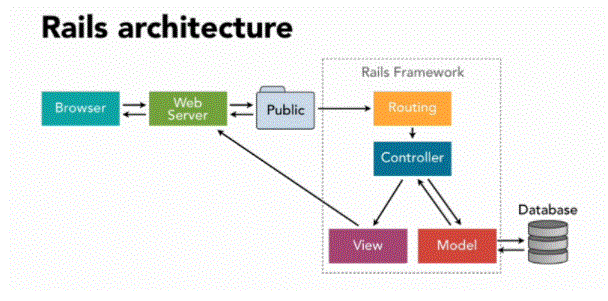
- Ruby on Rails is the 11th most popular web framework
- Number of websites built on Ruby on Rails
- Developers need minimal resources to work with Ruby on Rails.
- It supports development on a low budget
- It cuts down on development time
- Prototyping can be completed faster
- Contains pre-built plugins that reduce lengthy and tedious coding
- An enthusiastic community contributes to the Ruby on Rails framework, making it ideal for beginner programmers
- It’s a coherent and well written code, without extraneous elements that you would find in other languages
- Framework enables easy testing
- In addition, Ruby is always evolving as its creator and the support community is always working to improve it. For example, the planned release of Ruby 3 is expected to be three times faster (Ruby 3×3) in future. The faster speeds will improve the user experience in various areas including gaming.
Market Trends for Learning Ruby on Rails:
According to a 2019 Stack Overflow survey, more than 97,000 developers have ranked Ruby on Rails as the 12th most popular programming language and 11th most widely used web framework. 50.3 percent of developers already using Ruby on Rails expressed their interest to continue using the language.
Although opponents of Ruby say it is dying or dead, numbers vary. An analysis by Bankency Technology reveals that around 1.4 million websites are built on Ruby on Rails. The websites belong to a variety of industries and include popular websites such as Kickstarter, Basecamp, Zendesk, SlideShare, CrunchBase, Airbnb, and Shopify.
Some of the reasons for its continued popularity include:
- Ruby on Rails developers are still in demand 15 years after the introduction of the framework, and this is shown by the impressive portfolio of companies that use it. As mentioned above, companies using Rails benefit from faster delivery speeds and an agile development approach. Some of the top companies that use Ruby on Rails include GitHub, Airbnb, Zendesk, Shopify, Basecamp, Twitch, and Cookpad.
- A current search on LinkedIn reveals that in the United States alone, more than 3,400 new Ruby on Rails jobs were posted in December 2019 alone. Additionally, the impressive salary that RoR developers take home shows that knowledge of Ruby is something companies are willing to invest in. It represents new career opportunities.
- In fact the latest data shows that in the United States, a Ruby on Rails developer earns around $122k per year. In the United Kingdom, RoR developers earn an average of £50,520, with more experienced developers earning as much as £85,000. In India, RoR developers earn on an average ₹719,222/year.
- If you compare some of these figures with software developer salaries from different countries around the world, you will see that they stack up nicely. For example, software developers in Switzerland earn an average of $82,000, while the figures above show that Ruby on Rails developers are earning far more than in the US and UK.
Career Prospects for Ruby on Rails:
- There are many ways to learn Ruby on Rails, and given that it’s a very beginner-friendly language, it shouldn’t take you long to become proficient. However, while you can take some free tutorials online, it is always worthwhile to enroll in a certification course like Full Stack Web Developer – MEAN Stack Course that will enable you to gain expertise in the most popular MEN’s front- and back-end JavaScript technologies. makes.
- (MongoDB, Express, Angular and Node.js) Stack. Learn how to build applications from the ground up and embark on one of the most lucrative and rapidly growing web development career paths. You will benefit from the support of the instructor and you will have access to a support community of other professional programmers. If you are dedicated, you will start coding and building applications by the end of the course. Like everything that involves technology, the journey doesn’t stop after you get certified. Things change in the programming world, and you must keep learning to stay ahead.
- After your course, it is advisable to join forums, continue reading relevant material, and attend workshops and webinars. If you’re looking for a long-term position at a company, consider starting with an internship so you can prove yourself. If you work as a freelancer, join some of the platforms that will allow you to find freelance jobs.
- To be successful in your applications, prepare for your interview by practising with real-world problems. It is also helpful to anticipate the types of interview questions you will be asked for potential programming jobs. The more prepared you are, the better your chances of landing the Ruby on Rails job of your dreams.
Get Your Career on Track by Learning Ruby on Rails:
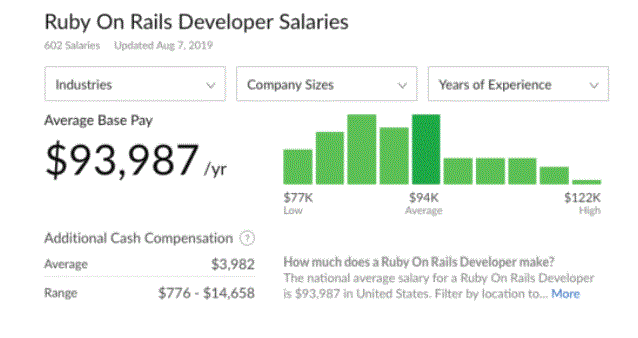
Need For Ruby On Rails Training:
To meet the resource demand and bridge the huge skill gap, professionals should give importance to RoR training. ROR training has become so essential that organisations are also honing their innate talent. During the training, developers can learn the root of this technology which will aid in their career growth.
ROR is becoming more efficient due to its latest achievements; JRuby, Ruby 1.9, and Rubinius. And with many organisations benefiting from breakneck speed delivery and an agile way of developing applications in Rails, the demand for Ruby on Rails is skyrocketing. Therefore, ROR training will open new opportunities.
Ruby on Rails is the preferred choice among web developers. Programmers prefer Ruby on Rails because it helps them to abstract and simplify common repetitive tasks. Here are some more reasons to go for Ruby on Rails:
Faster – This can significantly speed up the development process and provide a cleaner code base. It also allows you to reuse its existing components.
Cost Effective – It is highly automated and helps effectively in cutting critical sections of the entire project.
Great choice – not only does it combine some of the best features of dynamic languages, but it also uses effective solutions from static languages.
Open Source – Both the framework and most of its libraries are open-source. Rails itself runs on Linux, which is also open-source.
Flexibility – Adding new features, applying changes to the data model, and other modifications can be done easily.
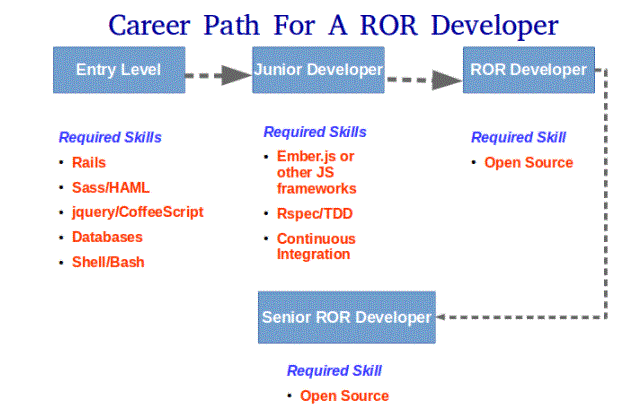
- When it comes to versatility, Ruby on Rails outshines most traditional programming languages. Also, most web developers love it for its streamlined and concise syntax.
- Ruby on Rails provides an efficient and easy to work platform and in situations where rapid website development is required.
- There is another major reason behind RubyGames popularity. This package manager makes it very easy to develop and distribute software libraries or gems.
Advantages of Ruby on Rails:
Ruby on Rails framework is now widely used for building websites. Some of the benefits of using this framework are: The main advantage of Ruby on Rails is that it offers immense freedom and flexibility. With just a few lines of code, this framework lets you do more things than other programming languages:
- Laura McGarrity, Mondo’s Vice President of Digital Marketing Strategy also confirms this and cites that Ruby on Rails is the third largest skill in demand and has remained stable over the years. This is exactly what the job portal is indicating about the huge demand for Ruby on Rails skills.
- The cost-saving and low upfront investment features make Ruby on Rails a hot technology and increase the importance and demand of RoR developers. And the employment rate for RoR developers drives the popularity of Ruby on Rails. There are many Ruby on Rails job opportunities in Ruby on Rails ranging from entry-level jobs to junior programmers and co-developers to high position jobs such as Chief Technology Officer, Project Lead and Senior Developer.
- According to PayScale, the demand for Ruby on Rails skills has quadrupled in the last 5 years and is proving to be a valuable addition to a developer’s resume. This is also 4.5 times higher than the proportion of workers who reported it as an important skill five years ago.
- Despite the increasing demand for Ruby on Rails skills, there is a huge shortage in the supply of talent skilled in this technology. Several survey companies have come to the conclusion that many major organisations across the globe are facing this talent shortage and India is one of them. There is a huge gap between demand and supply of the right expertise and with Ruby on Rails training this gap can be greatly reduced.
Demand for Ruby on Rails Skills:
According to Katie Bardaro, Chief Economist at PayScale, Ruby on Rails skills can really make a difference in the careers of developers in terms of job satisfaction and employment opportunities. Here are some more reasons:
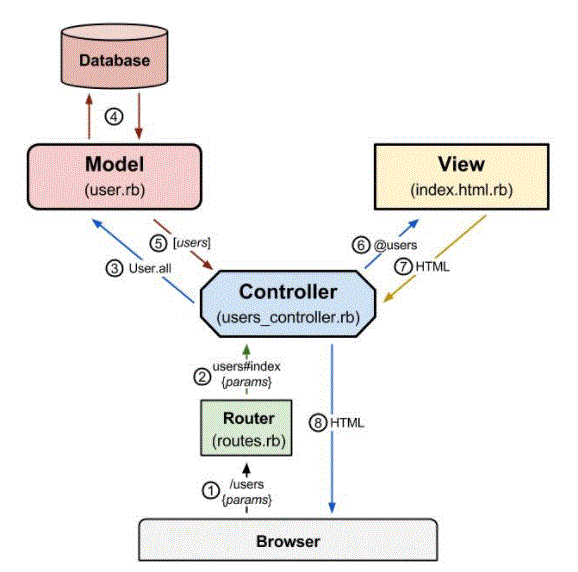
Roles & Responsibilities of a Ruby on Rails Professional:
Entry Level Responsibilities: Responsibilities of an entry-level Ruby on Rails developer include setting up the Rails environment, managing the database, handling requests, basic HTML, JavaScript and CSS knowledge, and performing the necessary tasks related to the development of RoR applications.
Mid-Level Responsibilities: The mid-level RoR developer role requires knowledge in ActiveRecord associations, design patterns, and object orientation.
Senior Level Responsibilities: Senior level Ruby on Rails developers should be knowledgeable in Ruby metaprogramming, database modelling, monitoring skills, planning and estimation. Another important skill that senior RoR developers must possess is sufficient analytical abilities to identify memory and performance issues.
Rails 2014 ended with the release of 4.2 final. Here are some of the new features:
ActiveJob – With the new ActiveJob library, Rails provides a unique queuing interface that allows you to swap queuing gems without changing the application code.
Sufficient Records – A set of performance improvements in Active Record that make normal searches and searches by calls and some associated queries up to 2x faster.
Web Console – Provides a REPL on Rails exception pages. It has the ability to place a console on any page in a Rails app.
Why use Ruby on Rails (RoR)?
Giving an interview in 2005, Rails designer David Heinemeier Hansen said, “Ruby is an extremely easy programming language used for building web applications.
Ruby is a general-purpose programming language that has tailored syntax and does not require excessive additional punctuation”.
Ruby is streamlined as compared to Java as it does not require extensive code to create basic structures like data fields. Also, Ruby eases the task of using high-level abstractions such as metaprogramming.
Conclusion:
Ruby on Rails is an open-source software used to build web applications. Rails is a framework used to build websites using the general purpose programming language Ruby. Ruby ranks among the top ten programming languages mainly because of the ambiguity of Rails.
Ruby on Rails was created by David Heinemeier Hansen and is often referred to as “Rails”. It mixes Ruby with HTML, JavaScript and CSS to build web applications that run on web servers. It is generally considered to be a server-side web application development platform. Rails catalyse the process of building complex sites. Engine Yard CEO John Dillon said the productivity of Ruby in Rails is anywhere from 2 to 2.5 times that of comparable Java programmers.



